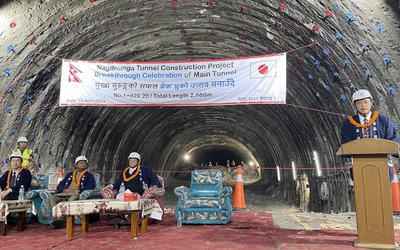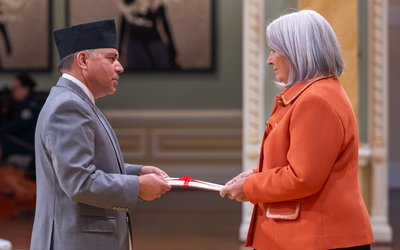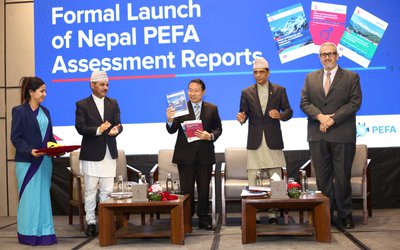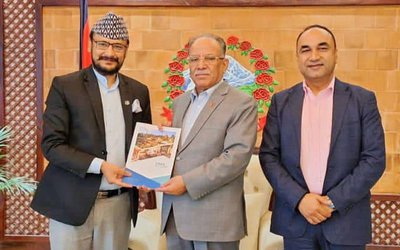
- Preliminary Observations
Nepal’s House of Representatives (the Lower House of Parliament) has been dissolved by the President on the Prime Minister’s recommendation, and dates for new elections have already been announced. Nearly 14 public interest litigation cases are being heard by the Supreme Court’s Constitutional Bench against the Government’s decision of the Lower House dissolution. No stay order has however been given by the court.
Any utterance intended directly or indirectly to influence or undermine the five-member Constitutional Bench headed by the Chief Justice of the Supreme Court is certainly unhealthy. It is tantamount to violation of constitutional principles, politico-legal morality, and judicial independence. The recently published comments, interviews and statements by lawyers, political scientists, former justices – including a statement by four former Chief Justices –are most unusual and constitutionally questionable, as they may impose pressure on the court. The frequent street shows on subjudice cases, seemingly supported by political parties and individuals that themselves played a crucial role in the Constituent Assembly and advocated the independence of judiciary and democracy, tend to undermine the value of the Constitution, rule of law, and justice system.
The main purpose of writing this article, however, is not to seek answers to the serious constitutional questions under Court’s consideration. It is meant neither to support dissolution nor to oppose it. Rather, it is to provoke constitutional scholars and political scientists to utilize the opportunity as it presents itself to save from further derailment our unique and preliminary as yet fully undefined parliamentary, federal Constitution. Thispreliminary observation of issues involved in the abrupt dissolution of Nepal’s House of Representatives (HOR) by the Prime Minister may help the Constitutional Bench constituted to hear the dissolution-related cases, the lawyers representing both parties, as well as those engaged as amicus curiae. Without unnecessarily stretching the arguments on legal paradoxes and underlying political intricacies, an attempt is made to directly address the matters that will engage the justices in the court for days to come. As one attempts to get to the core of the disputed subject, with the high voltage discourse and extreme polarisation within the political and legal communities, one has to take a risk of opening in the national interest and in favor of federal constitutionalism and rule of law.
- Issue of Constitutionality
The dissolution of the HOR as declared by the President of Nepal on the recommendation of Prime Minister KP Oli under the present Constitution appears prima facie to be unconstitutional, as raised in the petitions and comments of many legal experts. However, the political dimension of the dispute was polluted from the very outset by senior politicians, particularly of the ruling parties, due to their inherent and acute in-house differences. The obvious victims of their political anarchism were the nascent federal Constitution and its institutions, such as the presidency, Parliament, premiership, political parties, the Constitutional Council, and even the judiciary. The consequence of the unsavory infighting and dirty political games was the ‘early termination’ of the HOR, which in turn has now created political uncertainty and a constitutional vacuum. Amidst all this, a little ray of hope is seen in the call for an ‘early poll’ which allows the public at large, through the electoral ballot, to ensure the poor performance of the political parties and the dirty games they have played. The indication by the opposition parties, mainly the Nepali Congress and the RPP, that they will participate in the polls if the Supreme Court clears the way is a positive sign.
a) Constitutional Power of Dissolution
The governing principles of textual interpretation exploring the intended meaning of the words of the Constitution indicate that when the Parliament exhausts all given options to produce a new Prime Minister, the last candidate of the President’s choosing if defeated at the floor of the House, has a right to recommend dissolution. Once Parliament fails to produce a new Prime Minster under Article 76, such a defeated Prime Minister is in fact mandatorily obliged under Article 76 (7) to recommend dissolution to the President, who is also constitutionally obliged to accept such a recommendation. Interestingly, however, there is an inherent inconsistency, creating deep cleavage, in Constitution, in relation to Articles 76 (7)with Articles 74, 75 and 85, which has escaped the eyes of even the most eagle-eyed among our well-known constitutional experts. This inconsistency rupturing a cleavage can be considered dangerous.
Many legal and judicial luminaries, including former Chief Justices and former Speakers of the House, seem to have encountered difficulty in penetrating this inconsistency, or gap, in the constitutional text. There is indeed a wide gap between the provisions allowing dissolution as recommended by the defeated Prime Minister under Article 76 (7)and the space for early termination of HOR by a Prime Minister holding an absolute majority in the House under Articles 74 and 85. No one has given enough thought as to what happens, for example, if a defeated Prime Minister of presidential choice does not recommend dissolution to the President as prescribed by Article 76 (7). The President cannot declare dissolution suo motu, and a defeated Prime Minister may otherwise continue to head as the caretaker government so long as a new Prime Minister is not appointed. This is a risk-ridden lacunae hidden within the Constitution and must be termed an erroneous clause. When the terms and text in the Constitution alone cannot help in interpretation, the members of the Constitutional Bench have the responsibility to bank on the principle of harmonious interpretation to clear the fault-line.
b) Dissolution Options
Article 85 provides for a five-year tenure of the HOR, unless ‘dissolved’ earlier, which appears to allow dissolution, as stated earlier, only if a defeated Prime Minister under Article 76 (7) recommends it. This particular provision for dissolution of HOR operates only when Parliament is unable to produce (or elect) a new Prime Minister either right after the election of the HOR or when a Prime Minister’s position is vacant due to resignation or defeat in the vote of confidence motion. In this sense, the provision of dissolution prior to automatic dissolution at the end of HOR’s five-year tenure becomes dysfunctional and inoperative, unless a defeated Prime Minister is not prepared to go for dissolution. While dealing solely with the constitutionality of the faulty dissolution provision under Article 76 (7) and Article 85, the Constitutional Bench will have to seriously consider possible options to ensure effective operationalization of Article 76 (7)even if a defeated Prime Minister on the floor does not recommend dissolution. Moreover, the question of the incumbent Prime Minister’s power of dissolution under Nepal’s reformed parliamentary system exclusively based on articles 74 and 85 is yet to be analyzed and explained.
Otherwise, all arguments in favor of ‘limits’ on dissolution created by the norms of constitutionalism under our 2015 Constitution will strengthen the hand of defeated prime ministers to play unfair games against the values of rule of law and constitutionalism in relation to parliamentary dissolution. Thus, simply challenging the constitutionality of dissolution is not enough.
c) Undefined Article 74?
In addition to clarifying the restricted meaning of Articles 85 and 76 (7), the scholars and advocates of political constitutionalism have to work hard to innovate a new way to deal with the issue of establishing a prime minister’s power-relationship under the unique three-tier federation, exercising state authority as directed by Articles 2, 56-58 and Schedule 5-9with parliamentary systemic executive power as authorized by Articles 74, 75 and 76 (7). The residual authority of the Federal Government under Article 58and Schedule 5 (35) enables the Central Executive to give wider universal meaning to the undefined federal parliamentary system under Article 74.
Despite any existing personal political allegiance, there is an added burden on the individual amicus curieat this juncture to offer a manageable constitutional outlet and practical political options. Since the present Constitution is a multi-order federal document that articulates several new elements of constitutionalism, many of the old precedents and principles developed by earlier larger constitutional benches may not be fully applicable. Innovations may therefore be required to respond to many challenging politico-constitutional issues raised in the present case of dissolution. The amici curiae may also have to ask the Court to consider possible consequences of dealing with the political question as to what would happen if the Court issues writ orders and declares the dissolution unconstitutional. In this situation, both the President and Prime Minister will be morally obliged to immediately resign, and the HOR would return to the status quo ante. The Vice President, officiating as president, would summon the HOR sessions, and a process to elect a new Prime Minister under Article 76would be initiated. The country will then have the new task of holding elections to choose a new President, pushing the country to another round of political instability.
The issue of ‘constitutionality’ cannot be said to have been properly interpreted simply because several former Chief Justices and Supreme Court judges have opposed the dissolution. Each member of the Constitutional Bench, mandatorily headed by the incumbent Chief Justice, will have to apply his own mind fairly, independently and with competence, keeping national interest and the future of the federal constitutional order as the top priority.
- Arguments favoring Dissolution
Assuming that there was no writ petition filed at the Supreme Court, the country at this point would already be halfway through the process to the parliamentary polls seeking a fresh mandate for the potential new government. While the PIL cases may have reduced the momentum, the National Election Commission will continue preparing for the elections until and unless the Supreme Court gives a verdict against dissolution. Moreover, the Government claims it had consulted the Commission prior to the dissolution of the Lower House before announcing the dates for early elections as per Section 6 (1) of the House of Representatives Election Act 2074 (BS). This provision does not prevent the Prime Minister to declare early elections for the fresh poll at a date of his choice, and Article 74 does not prohibit a ruling Prime Minister under the present hitherto undefined “plural, multiparty, the federal parliamentary system” to dissolve the House and seek a fresh mandate from the people. If the prime minister’s own party, the Speaker, and the opposition do not cooperate but create obstructions in governance, the Prime Minister may count this as ample ground for dissolution under normal circumstances.
a) Unique Federal Parliamentarianism
Nepal has a three-tier federal governance model that is unique. The ‘pluralistic, multiparty, republican, federal government system is the basis of the parliamentary governance structure at the central level (Article 74). Nowhere does the Constitution define this structural parliamentary model. Unlike in India and the UK, here the executive power rests in the Council of Ministers headed by a Prime Minister (Articles75, 76, 77). The Federal Parliament is bicameral, and the President is not a part of the Parliament as is the case in India and the UK. The seven provincial sub-governments are also designed as parliamentary, responsible to produce Chief Ministers accountable to the Provincial Legislatures with the Federal Parliament. Although Provincial Legislatures are unicameral and can be dissolved before their normal five-year tenure, interestingly, however, the third tier of 753 local sub-governments is designed after the presidential model, and unlike the federal and provincial legislatures, cannot be dissolved before their five-year fixed term is up. The executive and legislative heads are the mayors directly elected by the people, and they cannot be removed earlier. Hence, the very nature of the parliamentary governance model under Nepal’s constitutional system, especially limited at the federal and provincial levels, needs to be seriously examined, understood and the understating regarding them has to be refined. Since the Constitution does not define the ‘pluralistic federal parliamentary governance model’ at the federal level under Article 74, this provides flexibility to the Federal Executive (i.e., the Council of Ministers) to explain under Articles 58, 75 and Schedule 5 (35)the meaning of the new parliamentary model. Thus, the power of dissolution of HOR, with its normal five-year tenure (Article 85), is not as easily explained as attempted in the PIL petitions before the Supreme Court. The Constitution and underlying principles of each provision have to be perused exhaustively if one is to get at the real meaning of federal parliamentarian and House dissolution.
b) Federal Residuary Power
A review of Articles 2, 56-58, and Schedule 5 (35)read together, would thus indicate that the Federal Government headed by Prime Minister is authorized to exercise ‘residuary executive power’ to interpret the linkages between article 74andArticle 85 with regard to the overall scope of dissolution of Parliament, while article 76 (7) is restrictively applicable only in the context of electing a new Prime Minister. The scope of Article 74 is certainly wide and it offers enough space for a Prime Minister to dissolve the Lower House before the HOR’s five-year term is over, in situations other than the floor test alone as narrowly raised by petitioners.
The PIL petitioners have ignored the need to explain issues such as: what happens when an annual policy statement of the President at the House is not approved by the Parliament? Or if an annual budget is not passed? If the Prime Minister’s own party repeatedly threatens to dislodge him or impeach the President, he does have options either to resign and seek a vote of confidence in the House or take a risk and go to the people – in essence democratically asking the ‘trouble makers to face the people through elections. Should the apex court deny the ‘Executive Head’ from going to the people? Is it not a travesty to demand that the apex court intervene on what is exclusively a ‘political question’, un-related to matters of constitutionality?It is the Prime Minister as a Leader of the House, not the Constitutional Bench of the Supreme Court, who has the first right of interpreting constitutional provisions related to parliamentary practice, Nepal’s unique federal parliamentarism, and the matter of parliamentary dissolution.
One must add the following cautionary note for those supporting the PIL petitions and who seek the transfer of the cases from the Constitutional Bench to a full bench of the Supreme Court: Distrusting a ‘Constitutional Bench’ (Article 137) created after such a long debate in the Constituent Assembly for giving final meaning to the constitutional provisions is itself an expression of distrust in the Constitution. The Supreme Court cannot simply abdicate its inherent judicial power of constitutional interpretation through ‘Constitutional Bench’ simply because a few lawyers so demand. Under the globally accepted comparative parliamentary practice, there is nothing to prevent a Prime Minister from relying on constitutionalism to recommend dissolution under Articles 2, 5, 56, 57, 58, 74 and 85.The Prime Minister’s power to declare dissolution and early poll, differently from Article 76 (7), is supported by Section 6 (1) of the House of Representatives Election Act 2074 (BS) and international conventions.
- Options and Way out
As briefly mentioned above, defining an undefined issue related to a new constitutional and parliamentary order is certainly a big challenge for the five members of the Constitutional Bench. Indeed the Bench has become a focus of public interest and, at the same time, the repository and symbol of the people’s faith in the judiciary. Clearly, the design of the federal multi-party parliamentarianism of Nepal offers two options for the Parliament’sdissolution. Firstly, the option relates toa defeated Prime Minister when the House is unable to produce a new Prime Minister under Article 76 (7); and, secondly, the option which may a bit hazy but offers wider space for dissolution by the incumbent Prime Minister in the exercise of his federal executive powers under Articles 74 and 75, together with the ‘federal residuary power’ under Article 58. This option is further supported for implementation by Section 6 (1) of the House of Representatives Electoral Act 2074 (BS) as well as comparative international parliamentary practice.
The courts normally do not prevent the Executive from going to the people on valid political grounds presented by the ‘Executive Head’ based on the principles of the separation of powers and parliamentary accountability, to reach the people for a fresh political mandate to govern. Only in exceptional situations involving mixed constitutional and political questions, might a court intervene against the executive decision to disband a parliament.
The comparative parliamentary experiences of the democratic world show different ways of implementing parliamentarism that allows options to reach out to the people in the name of ‘political stability’. Political stability and ‘political flexibility’ go hand in hand; both are opposed to ‘political rigidity’. Reforms are always welcome, but they must be for the good.
Reforms introduced under the Fixed-term Parliamentary Act (2011)in the UK, implemented since 2015, in the name of political stability, acutely tied the hands of several Governments and prevent British Prime Ministers from carrying out urgent tasks. In 2019 AD alone, three successive recommendations of the British Prime Minister to dissolve Parliament was denied by Parliament as the Act required parliamentary endorsement. Consequently, both the Conservative Party and Labour Party were impelled to include in their party manifestos the commitment to repeal the Fixed Term Parliamentary Act. They are now preparing to introduce a bill to do away with the arrangement of restrictive dissolution that crippled the hands of the Prime Minister and the Government. So, such restrictive measures against dissolution experimented, in the name of stability, by the UK’s mature common law parliamentary system, has not worked.
In conclusion, let the sharp brains of competent lawyers offer sufficient materials to help enrich the arguments before the learned justices of the Constitutional Bench, to offer the right options for the sake of Nepali Constitutionalism and Parliamentarianism. Let no external pressure prevent the Constitutional Bench from going for the decision it sees to be proper.
- Summit For Democracy And Focus On Human Rights
- Jan 22, 2022
- Contempt of Court In Nepal
- Feb 18, 2018
- Constitutional Puzzle
- Dec 22, 2017
- Unique Local Governance Model
- Jul 09, 2017
- Federalizing Nepal
- May 05, 2016

















